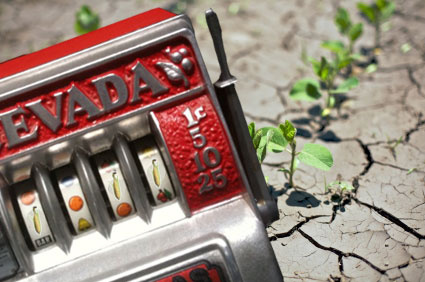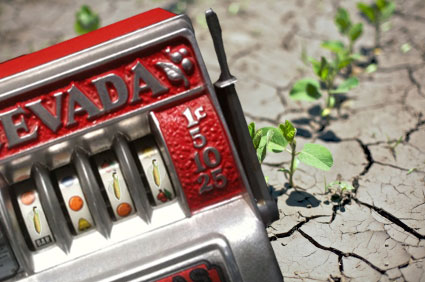 (Photoillustration by Grist)Financial blogger Felix Salmon has an essay in Foreign Policy called “How Locavores Can Save the World” — expanded, by the way, from a wonderful blog post he wrote after attending a panel discussion on world hunger at the Davos World Economic Forum in the company of Blue Hill Farm’s Dan Barber. Salmon usually focuses on issues involving economic crises, monetary policy, complex derivatives, macro-economics, and governmental oversight of the financial markets, but here he’s talking monocultures, sustainable agriculture, and transgenic seeds. Tom Philpott has in the past opined on the similarities between financial and food crises, so I suppose this turn of events is not too surprising.
(Photoillustration by Grist)Financial blogger Felix Salmon has an essay in Foreign Policy called “How Locavores Can Save the World” — expanded, by the way, from a wonderful blog post he wrote after attending a panel discussion on world hunger at the Davos World Economic Forum in the company of Blue Hill Farm’s Dan Barber. Salmon usually focuses on issues involving economic crises, monetary policy, complex derivatives, macro-economics, and governmental oversight of the financial markets, but here he’s talking monocultures, sustainable agriculture, and transgenic seeds. Tom Philpott has in the past opined on the similarities between financial and food crises, so I suppose this turn of events is not too surprising.
But the bit I found most striking was how Salmon characterized Big Ag’s claim that genetically modified organisms are an “answer” to the problem of world hunger:
[It] is the agricultural equivalent of creating triple-A-rated mortgage bonds, fabricated precisely to prevent the problem of credit risk. It doesn’t make the problem go away: It just makes the problem rarer and much more dangerous when it does occur because no one is — or even can be — prepared for such a high-impact, low-probability event.
Well, hey. That’s a new one. GMOs as CDOs (i.e. Collateralized Debt Obligations), the mortgage-backed securities that helped destroy the economy as we knew it. But I wanted to hear more details. So I asked Salmon if he might expand on the analogy. And this post was his response:
The point here is that a disease-resistant crop is a lot like a triple-A-rated structured bond: they’re both artificially engineered to be as safe as possible. That would be a wonderfully good thing if no one knew that they were so safe. But if you’re aware of a safety improvement, that often just has the effect of increasing the amount of risk you take: people drive faster when they’re wearing seatbelts, and they take on a lot more leverage when they’re buying AAA-rated bonds.
The agricultural equivalent is the move to industrial-scale monoculture, “safe” in the knowledge that lots of clever engineers in the US have made the crop into the agribusiness version of a bankruptcy-remote special-purpose entity.
But the problem is that bankruptcy-remote doesn’t mean that bankruptcy is impossible: just ask the people running Citigroup’s AAA-rated SIVs [Structured Investment Vehicles — another risk management financial “innovation” that failed spectacularly]. If and when the unlikely event eventually happens, the amount of devastation caused is directly proportional to the degree to which people thought they were protected. When something like that goes wrong, it goes very wrong indeed: artificial safety improvements have the effect of turning outcomes binary.
Essentially, you’re trading a large number of small problems for a small probability that at some point you’re going to have an absolutely enormous problem.
In a sense, Big Ag — along with the Obama administration — is doubling down on the industrial system we have now: one that is already starting to show signs of stress, from the rise of superweeds along with the price of oil. Monsanto and Syngenta are claiming the ability to genetically engineer all the risk out of agriculture. But in narrowing farmers’ choices to a small set of patented seeds, seeds that must be bought by and distributed to every far-flung farm in the world every year (most of which lack basic infrastructure like, say, roads, and which must grow them according to strict protocols), these companies presume to have managed all the risks, just like the banks did a few years back. They are also presuming that the “Business as Usual” scenario, the world as it exists today, will continue indefinitely; that, in other words, there are no Black Swans hiding in the reeds.
As Salmon describes it for us so clearly, it’s a huge gamble. Only this time we’re not gambling with money — we’re being asked to gamble with our breakfast, lunch, and dinner, and farmers with their livelihoods. That is a bet that none of us should have to take.
The good news is we don’t. Between Dan Barber-style “regionalized breeding” as a bulwark against disease and the kind of sustainable agriculture sketched out in the U.N.’s landmark IASTAAD report, a practical alternative to Big Ag’s vision exists. The question is, must we wait for the Black Swan to take flight before we enact it?



